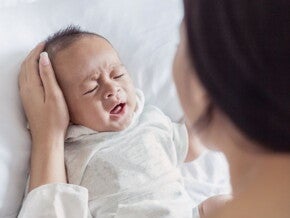
Bronchiolitis is a chest infection caused by viruses such as respiratory syncytial virus (RSV) or influenza that leads to inflammation of the small airways in the lungs, making it harder for babies to breathe.
While bronchiolitis can be distressing to watch, many cases are mild and resolve on their own with supportive management. Knowing the early signs, what to expect, and how to care for your child at home can make all the difference. In this guide, you’ll find expert-backed information on bronchiolitis in infants symptoms, diagnosis, treatment, and when to seek medical help so you can feel confident caring for your baby.
What is bronchiolitis in infants?
Bronchiolitis is a viral chest infection that causes swelling and mucus build-up in the bronchioles, the tiny airways in the lungs. This makes it harder for babies to breathe and can affect feeding and sleep.
The most common virus that causes bronchiolitis is respiratory syncytial virus (RSV), which typically circulates during colder autumn and winter months. Other viruses such as influenza, parainfluenza, and rhinovirus can also cause bronchiolitis.
Infants under 6 months, especially those under 3 months, are at higher risk of developing more severe bronchiolitis because their lungs and immune systems are still developing. They also have much smaller airways compared to older children, and any congestion or swelling can narrow their airways more easily. Air then becomes trapped in the lungs and your child may have fast or noisy breathing as a result.
The virus spreads through droplets in the air from coughing, sneezing, or by touching contaminated surfaces. Because infants often explore their environment with their hands and mouths, they are especially vulnerable. There is an increased risk in winter months because the cold weather means infants and families congregate indoors, which increases exposure and spread between each other.
Risk factors for both contracting and having more severe bronchiolitis include:
- Premature birth;
- Congenital heart or lung disease;
- Exposure to tobacco smoke;
- Age under 6 months;
- Immune-compromising conditions;
- Living in crowded households or attending daycare.
Recognising symptoms of bronchiolitis in infants
Bronchiolitis often begins like a common cold. Bronchiolitis in infants symptoms you might notice in your infant include:
- Mild cough;
- Runny nose;
- Blocked nose;
- Sore throat.
Over the next few days, symptoms may often worsen as the airways become more inflamed. You may notice:
- Fast or shallow breathing;
- Wheezing or noisy breathing;
- Persistent cough;
- Fever;
- Feeding difficulties due to shortness of breath.
Sometimes, symptoms can become more severe and need urgent attention. If you see any of these symptoms, seek medical review:
- Laboured breathing (chest sucking in, flaring nostrils);
- Grunting or pauses in breathing;
- Bluish or greyish lips or fingertips;
- Extreme tiredness or difficulty waking;
- Signs of significant dehydration (fewer wet nappies, dry mouth).
Most symptoms will peak around day 3 to 5 and then start to improve. Recovery can take 1 to 2 weeks, although the lingering cough may persist longer.
What causes bronchiolitis in infants?
Bronchiolitis is caused almost exclusively by viruses, not bacterial. Antibiotics do not help in viral infections unless a secondary or superimposed bacterial infection develops as a complication of bronchiolitis. The main viral organisms that cause bronchiolitis include:
- Newborn RSV – the most common and often more severe in infants;
- Influenza (“flu”);
- Rhinovirus;
- Enterovirus;
- Parainfluenza virus;
- Adenovirus.
Viruses spread easily through coughs, sneezes, touching toys or surfaces, and close contact in daycare or group settings. Babies are more susceptible because of their immature immune systems and small airways.
How is bronchiolitis diagnosed in infants?
In most cases, bronchiolitis is diagnosed based on a physical examination and symptom history by a doctor.
Your GP or paediatrician may:
- Listen to your baby’s breathing and lung sounds with a stethoscope;
- Check their temperature and respiratory rate;
- Look for signs of difficulty breathing or dehydration.
In moderate to severe cases, the following tests might be used:
- Pulse oximetry to measure your child’s oxygen levels;
- Nasal swab to test for the specific virus such as newborn RSV or influenza which may be causing the bronchiolitis;
- Chest X-ray (rarely needed unless complications such as bacterial pneumonia are suspected).
Understanding the differences between bronchiolitis and other infant respiratory issues
It’s normal for parents to worry when a baby is congested, especially if there’s coughing or breathing changes. However, not all respiratory symptoms indicate that your child has bronchiolitis. Recognising how bronchiolitis differs from other respiratory conditions such as a common cold helps you to provide the right care and seek help when needed.
- Newborn cough: Newborns may cough due to a mild cold, reflux or even because of changes in temperature and dry air. A cough that persists and worsens, especially when combined with other symptoms such as fast breathing or poor feeding, may suggest the development of bronchiolitis.
- Common cold: A common cold often presents with milder symptoms such as a cough or runny or blocked nose. It may progress, and if symptoms such as wheezing or laboured breathing develop, your infant may have developed bronchiolitis
- Bacterial Pneumonia: Bronchiolitis is usually caused by viruses. Bacterial lung infections on the other hand, also known as bacterial pneumonia, are less common in this age group. These infections often affect the air sacs called alveoli, which are responsible for exchanging carbon dioxide for oxygen. They may cause similar or worse symptoms such as persistent high fevers and low oxygen levels and may require antibiotic treatment.
Home care tips for managing bronchiolitis in infants
Most cases of bronchiolitis are mild and can be safely managed at home after speaking with your doctor. Here are some supportive care tips to help your baby recover:
- Saline nasal drops or spray to loosen mucus;
- Gentle suctioning with a bulb syringe or aspirator to clear their nasal passages – infants are unable to blow their nose to clear their nasal passages;
- Offer small, frequent feeds to maintain hydration and energy;
- Use a humidifier to moisten dry air and ease breathing;
- Keep your baby upright during feeds or while resting to help breathing;
- Monitor temperature and avoid overdressing if they have a fever;
- Consider giving paracetamol or ibuprofen if they are miserable or irritable;
- Do not smoke or vape inside the house or around your baby.
Keeping your baby hydrated is one of the most important things. Signs of dehydration include fewer than four wet nappies in 24 hours, dry lips, or sunken fontanelle (soft spot on their skull).
Medical treatment of bronchiolitis in infants and when to seek help
There is no specific medication to cure bronchiolitis and it typically tends to resolve on its own. Since it is caused by a virus, antibiotics are not effective as treatment. Likewise, steroids, salbutamol or antihistamines are not effective in bronchiolitis treatment. If you are concerned about your baby’s health, always speak to your doctor.
In some cases, urgent medical treatment or hospital care may be necessary if you notice your baby has any of the following symptoms:
- Has trouble breathing with very fast breaths, difficulty breathing or wheezing;
- Has low oxygen levels;
- Is not feeding (eating or drinking) as much as usual;
- Becomes dehydrated;
- Very tired and hard to wake or irritable;
- Are pale and sweaty;
- Deteriorating very quickly;
- Has developed a complication of bronchiolitis.
In hospital, treatment may include:
- Breathing support (oxygen or respiratory therapy) if your baby is unable to maintain good oxygenation.
- Intravenous or nasogastric fluids if your baby is unable to feed enough to maintain hydration.
- Monitoring for complications like bacterial pneumonia or ear infections.
- Always contact your healthcare provider if you are unsure or worried about your child. Early support can make a big difference in your baby’s length and duration of recovery.
How to prevent bronchiolitis and protect your infant
While bronchiolitis is common, there are simple ways to reduce your baby’s risk of catching viruses from others:
- Wash hands frequently, especially before feeding or touching your baby;
- Keep toys and surfaces clean and disinfected;
- Avoid contact with people who have cold or flu symptoms;
- Keep older siblings’ hygiene in check, especially if attending daycare;
- Avoid tobacco smoke exposure, which increases severity.
Vaccinations also play an important role:
- Routine baby immunisations help prevent complications from respiratory infections;
- Annual influenza vaccination is recommended for infants over 6 months;
- Maternal immunisation against flu and whooping cough during pregnancy helps protect newborns in their first months;
- Maternal or infant preventative program for respiratory syncytial virus are also available to protect against RSV.
Frequently asked questions about bronchiolitis in infants
How long does bronchiolitis last in infants?
Most babies with bronchiolitis start to improve after about 5 to 7 days, although a mild cough may persist for up to 2 to 4 weeks. Bronchiolitis in infants symptoms typically peak around day 3 to 5 before settling. Every child recovers at their own pace, and rest, hydration, and home care play an important role in their recovery.
What are the symptoms of bronchiolitis in infants?
Bronchiolitis often begins with cold-like symptoms, such as a runny nose, mild cough, and low-grade fever. As the condition progresses, your baby may develop fast breathing, wheezing, and feeding difficulties. In more severe cases, symptoms can include laboured breathing, grunting, and signs of dehydration.
Is bronchiolitis contagious?
Yes, viruses that cause bronchiolitis are highly contagious and spread through droplets from coughing, sneezing, or touching contaminated surfaces. It can easily pass between young children in daycare or shared spaces, especially during winter months when viruses like RSV are more common.
How long is bronchiolitis contagious?
Babies are usually contagious for up to 10 days after symptoms begin, but they may continue to spread the virus even after feeling better. It's best to keep your baby home and avoid contact with other children especially those under 6 months or with health conditions until they are fully recovered.
How is bronchiolitis treated?
There is no specific medication to cure bronchiolitis, as it is caused by a virus. Treatment focuses on supportive care at home, such as clearing nasal mucus with saline and suctioning, keeping your baby well hydrated, and offering smaller, more frequent feeds. In more severe cases, hospital care may be needed for oxygen therapy or intravenous or nasogastric fluids. Antibiotics are not effective unless a secondary bacterial infection is present.
Sources:
- My Dr Website. Accessed at https://mydr.com.au/respiratory-health/bronchiolitis/
- Royal Children’s Hospital Website. Accessed at https://www.rch.org.au/kidsinfo/fact_sheets/bronchiolitis/
- National Health & Medical Research Council’s Website. Accessed at https://www.nhmrc.gov.au/about-us/publications/staying-healthy-guidelines/fact-sheets/Bronchiolitis
- Up to date Website. Accessed at https://www.uptodate.com/contents/bronchiolitis-and-rsv-in-infants-and-children-beyond-the-basics/print
- Health Direct Website. Accessed at https://www.healthdirect.gov.au/bronchiolitis
- Better Health Website. Accessed at https://www.betterhealth.vic.gov.au/health/conditionsandtreatments/bronchiolitis



